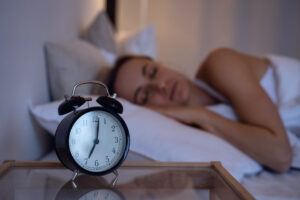When you buy through our links, we may earn a commission. Products or services may be offered by an affiliated entity. Learn more.
Tips for Shift Workers
Work schedules that fall anywhere outside the hours of 7 am to 6 pm are considered shift work. These schedules may consist of fixed hours, rotating or split shifts, or irregular work times. According to the Bureau of Labor Statistics, roughly 16% of full-time salary and wage workers in the U.S. worked non-daytime shifts in 2017 and 2018. Recently, many employees have also been forced to take on shift work in recent months due to the COVID-19 pandemic.
Shift work can be demanding when it comes to getting a good night’s sleep, especially for those who work night, early morning, or rotating shifts. Over time these employees may develop shift work disorder, a condition characterized by insomnia symptoms when they attempt to sleep and excessive tiredness while they are at work. Shift work disorder not only causes cognitive impairments and physical complications but also affects occupational performance and makes workers more prone to errors and accidents.
How To Set a Night Work Sleep Schedule
Sleep consistency is key for many employees working night shift schedules. If you wake up at 5 pm for your night shift and normally go to sleep at 8 am after getting home from work, then you also should maintain this sleep-wake schedule on your days off. Obviously, this can be difficult to accomplish. Make sure significant others, children, roommates, and anyone else sharing your roof understands the importance of your designated sleep time.
Light and noise exposure may be other issues for sleeping during the day. Try drawing the shades or sleeping with an eye mask if your bedroom tends to be bright during the day. Earplugs and white noise machines can be effective at blocking outside sounds. Unless you are on call, consider turning your phone off while you sleep. Getting a good night’s rest is essential and creating a bedroom environment conducive to rest can have a huge impact.
Rather than immediately going to bed, some shift workers prefer to stay up for a few hours after arriving home. This way, they can wake up closer to the time when they start their next night shift. For others, a split-nap schedule is more effective. This involves napping for a few hours after getting home in the morning and then sleeping for longer in the hours leading up to the next shift’s start time.
Before going to bed, consider a hot shower or bath, meditation, or another relaxing activity. Although alcohol has sedative properties that help you fall asleep more easily, you may experience sleep disturbances or fragmented sleep as your body breaks down the alcohol. Some shift workers take melatonin supplements to fall asleep during the day, but you should consult with your doctor before taking melatonin because it can have an impact on your sleep-wake rhythms.
Tips for Staying Awake During Shift Work
While you are at work during an irregular shift, strategies to stay refreshed and alert may include:
- Caffeine in moderation: Caffeine can provide an energy boost for shift workers, but it should be consumed carefully and in moderation. A cup of coffee or caffeinated soda is recommended at the beginning of your shift. The caffeine will usually take effect within 15-20 minutes. Moderate amounts of caffeine every one to two hours will be more effective than heavy amounts. You should avoid consuming caffeine within three to four hours of the time you plan to go to sleep.
- Get the blood moving: If you have enough time during a scheduled break, consider a brief workout or a jog around your workplace. Even a small amount of exercise can provide an energy boost.
- Take a nap: You can also snooze on your break if you’d rather sleep than exercise. A nap of 10-20 minutes is considered ideal because you won’t enter deep sleep and feel excessively groggy when it’s time to wake up. For some shift workers, the “coffee nap” can be effective. This strategy involves drinking a cup of coffee and then taking a nap that lasts 15-20 minutes. Your wake-up time will coincide with the caffeine in the coffee taking effect.
- Exercise caution: People who experience sleep problems due to shift work are at higher risk of on-the-job errors and accidents. The same is true of employees who are new to shift work, or those who are working shifts that are longer than usual.
- Consider a post-work snooze: Drowsy driving accidents are another hazard associated with shift work. According to the most recent statistics, midnight to 6 am is one of the most dangerous periods of the day for drowsy driving. If your workplace does not have a room where you can nap undisturbed, you can try dozing for a few minutes in your car before leaving the property. If you begin to feel drowsy behind the wheel, pull over at the next available opportunity where you can park safely and nap for a few minutes.
Finding the right system for you may require some trial and error. Most adults require seven hours or more of daily sleep, although some adults can get by on slightly less or slightly more sleep.
Tips for Employees With Rotating Shifts
Fixed shift work creates plenty of sleep challenges for employees, but rotating shifts that involve different start and times for shifts during a given week or month can exacerbate these issues. Rotating shifts vary by workplace, but some of the most common rotating schedules for employees include the following:
- Dupont: This schedule operates on a four-week cycle and consists of four different teams covering 12-hour shifts. A given team will work blocks of both day and night shifts lasting three to four days, interspersed with one to three consecutive days off. Each team also receives a seven-day block of days off for every four week period.
- Panama: Also known as 2-2-3 or the Pitman, the Panama schedule consists of four teams. Two teams trade day shifts throughout the week in two- or three-day blocks, while the other two teams trade off night shifts in two- or three-day blocks. Each team will receive seven non-consecutive days off every two weeks.
- Southern Swing: This schedule requires employees to work eight hours per shift for seven consecutive days. After each seven-day block of work, employees receive two to three days off. Upon returning to work, the employee’s team will adopt different hours from the previous seven-hour block. Most Southern Swing schedules rotate teams between day, swing, and night shifts.
Shift workers with rotating schedules should prepare for shift changes by adjusting their sleep times. Let’s say you are currently working a day shift and planning to rotate to a night shift the following week. You should gradually delay your bedtime by one or two hours each night a few days prior to starting the night shift if possible. This will help you get enough rest and avoid sudden changes.
Some rotating shifts are better for sleep than others. For example, rotating from day to afternoon to night shifts is a more natural progression that is easier on your body compared to rotating in the opposite direction or in random patterns. Rotating shifts every two to three days may also be better for workers than rotating their shifts every five to seven days, and too many consecutive night shifts can be problematic.
If you work a rotating schedule and the routine is wearing you down, consider having a word with your supervisor. They may be able to adjust your shifts or rotations and provide a schedule that is better for your sleep schedule.
References
9 Sources
-
Redeker, N., Caruso, C., Hashmi, S., Mullington, J., Grandner, M., & Morganthaler, T. (2019). Workplace Interventions to Promote Sleep Health and an Alert, Healthy Workforce. Journal of Clinical Sleep Medicine, 15(4).
https://pubmed.ncbi.nlm.nih.gov/30952228/ -
Bureau of Labor Statistics. (2019, September). Job Flexibilities and Work Schedules Summary. (USDL-19-1691).
https://www.bls.gov/news.release/flex2.nr0.htm -
American Academy of Sleep Medicine. (2014). The International Classification of Sleep Disorders – Third Edition (ICSD-3). Darien, IL.
https://aasm.org/ -
Lammers-van der Holst, H. M., Murphy, A. S., Wise, J., & Duffy, J. F. (2020). Sleep tips for shift workers in the time of pandemic. Southwest Journal of Pulmonary & Critical Care, 20(4), 128–130.
https://www.ncbi.nlm.nih.gov/pmc/articles/PMC7189699/ -
Brooks, A., & Lack, L. (2006). A Brief Afternoon Nap Following Nocturnal Sleep Restriction: Which Nap Duration is Most Recuperative? Sleep, 29(6), 831–840.
https://pubmed.ncbi.nlm.nih.gov/16796222/ -
National High Traffic Safety Administration. (n.d.). Drowsy Driving.
https://www.nhtsa.gov/risky-driving/drowsy-driving -
Consensus Conference Panel, Watson, N. F., Badr, M. S., Belenky, G., Bliwise, D. L., Buxton, O. M., Buysse, D., Dinges, D. F., Gangwisch, J., Grandner, M. A., Kushida, C., Malhotra, R. K., Martin, J. L., Patel, S. R., Quan, S. F., Tasali, E., Non-Participating Observers, Twery, M., Croft, J. B., Maher, E., … Heald, J. L. (2015). Recommended amount of sleep for a healthy adult: A joint consensus statement of the American Academy of Sleep Medicine and Sleep Research Society. Journal of Clinical Sleep Medicine, 11(6), 591–592.
https://pubmed.ncbi.nlm.nih.gov/25979105/ -
UCLA Health. (n.d.). Coping with Shift Work.
https://www.uclahealth.org/sleepcenter/coping-with-shift-work -
National Safety Council. (2017). Shiftwork: Challenges and Managing Risks.
https://www.nsc.org/Portals/0/Documents/Fatigue%20Documents/Fact-Sheets/Shiftwork.pdf












